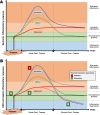Inflammation in Posttraumatic Stress Disorder: Dysregulation or Recalibration?
- PMID: 37550908
- PMCID: PMC10845099
- DOI: 10.2174/1570159X21666230807152051
Inflammation in Posttraumatic Stress Disorder: Dysregulation or Recalibration?
Abstract
Despite ample experimental data indicating a role of inflammatory mediators in the behavioral and neurobiological manifestations elicited by exposure to physical and psychologic stressors, causative associations between systemic low-grade inflammation and central nervous system inflammatory processes in posttraumatic stress disorder (PTSD) patients remain largely conceptual. As in other stress-related disorders, pro-inflammatory activity may play an equivocal role in PTSD pathophysiology, one that renders indiscriminate employment of anti-inflammatory agents of questionable relevance. In fact, as several pieces of preclinical and clinical research convergingly suggest, timely and targeted potentiation rather than inhibition of inflammatory responses may actually be beneficial in patients who are characterized by suppressed microglia function in the face of systemic low-grade inflammation. The deleterious impact of chronic stress-associated inflammation on the systemic level may, thus, need to be held in context with the - often not readily apparent - adaptive payoffs of low-grade inflammation at the tissue level.
Keywords: Posttraumatic stress disorder (PTSD); anti-inflammatory agents.; immune system; inflammation; microglia; neurobiology.
Copyright© Bentham Science Publishers; For any queries, please email at epub@benthamscience.net.
Conflict of interest statement
The authors declare no conflict of interest, financial or otherwise.
Figures


Similar articles
-
[Posttraumatic stress disorder (PTSD) as a consequence of the interaction between an individual genetic susceptibility, a traumatogenic event and a social context].Encephale. 2012 Oct;38(5):373-80. doi: 10.1016/j.encep.2011.12.003. Epub 2012 Jan 24. Encephale. 2012. PMID: 23062450 Review. French.
-
Metabolism, Metabolomics, and Inflammation in Posttraumatic Stress Disorder.Biol Psychiatry. 2018 May 15;83(10):866-875. doi: 10.1016/j.biopsych.2018.02.007. Epub 2018 Feb 22. Biol Psychiatry. 2018. PMID: 29628193 Review.
-
Involvement of microglia in disturbed fear memory regulation: Possible microglial contribution to the pathophysiology of posttraumatic stress disorder.Neurochem Int. 2021 Jan;142:104921. doi: 10.1016/j.neuint.2020.104921. Epub 2020 Nov 21. Neurochem Int. 2021. PMID: 33232758 Review.
-
Neuroinflammatory genes associated with post-traumatic stress disorder: implications for comorbidity.Psychiatr Genet. 2017 Feb;27(1):1-16. doi: 10.1097/YPG.0000000000000143. Psychiatr Genet. 2017. PMID: 27635478 Review.
-
Psychobiology of the acute stress response and its relationship to the psychobiology of post-traumatic stress disorder.Psychiatr Clin North Am. 2002 Jun;25(2):385-95. doi: 10.1016/s0193-953x(01)00005-3. Psychiatr Clin North Am. 2002. PMID: 12136506 Review.
Cited by
-
Microglia-mediated neuroimmune suppression in PTSD is associated with anhedonia.Proc Natl Acad Sci U S A. 2024 Aug 27;121(35):e2406005121. doi: 10.1073/pnas.2406005121. Epub 2024 Aug 22. Proc Natl Acad Sci U S A. 2024. PMID: 39172786 Free PMC article.
-
Effects of social dominance and acute social stress on morphology of microglia and structural integrity of the medial prefrontal cortex.Brain Behav Immun. 2024 Nov;122:353-367. doi: 10.1016/j.bbi.2024.08.043. Epub 2024 Aug 24. Brain Behav Immun. 2024. PMID: 39187049
-
Thematic Selection: Stress and Stress-related Disorders Posttraumatic Stress Disorder (Part 2).Curr Neuropharmacol. 2024;22(4):522-523. doi: 10.2174/1570159X2204231106143917. Curr Neuropharmacol. 2024. PMID: 38284340 Free PMC article. No abstract available.
-
Neurobiology of Chronic Pain, Posttraumatic Stress Disorder, and Mild Traumatic Brain Injury.Biology (Basel). 2025 Jun 7;14(6):662. doi: 10.3390/biology14060662. Biology (Basel). 2025. PMID: 40563913 Free PMC article. Review.
References
-
- Benjet C., Bromet E., Karam E.G., Kessler R.C., McLaughlin K.A., Ruscio A.M., Shahly V., Stein D.J., Petukhova M., Hill E., Alonso J., Atwoli L., Bunting B., Bruffaerts R., Caldas-de-Almeida J.M., de Girolamo G., Florescu S., Gureje O., Huang Y., Lepine J.P., Kawakami N., Kovess-Masfety V., Medina-Mora M.E., Navarro-Mateu F., Piazza M., Posada-Villa J., Scott K.M., Shalev A., Slade T., ten Have M., Torres Y., Viana M.C., Zarkov Z., Koenen K.C. The epidemiology of traumatic event exposure worldwide: Results from the World Mental Health Survey Consortium. Psychol. Med. 2016;46(2):327–343. doi: 10.1017/S0033291715001981. - DOI - PMC - PubMed
-
- Koenen K.C., Ratanatharathorn A., Ng L., McLaughlin K.A., Bromet E.J., Stein D.J., Karam E.G., Meron Ruscio A., Benjet C., Scott K., Atwoli L., Petukhova M., Lim C.C.W., Aguilar-Gaxiola S., Al-Hamzawi A., Alonso J., Bunting B., Ciutan M., de Girolamo G., Degenhardt L., Gureje O., Haro J.M., Huang Y., Kawakami N., Lee S., Navarro-Mateu F., Pennell B.E., Piazza M., Sampson N., ten Have M., Torres Y., Viana M.C., Williams D., Xavier M., Kessler R.C. Posttraumatic stress disorder in the World Mental Health Surveys. Psychol. Med. 2017;47(13):2260–2274. doi: 10.1017/S0033291717000708. - DOI - PMC - PubMed

